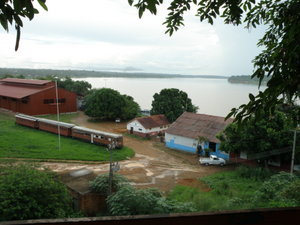Advertisement
Published: December 18th 2008

 Madiera-Marmora RR terminal
Madiera-Marmora RR terminal
here is the station where the railway stopped in Porto VelhoHowdy all
Right off the top I have to make it clear, I saw pink dolphins BEFORE we ate that traditional Amazonian Indian food.
We have been in Porto Velho for a few days now. Taking care of some business here. We met with a prospector who had a property we were interested in. We arranged for a couple of our guys to go in and sample the showing. Its 18 km into the jungle. Access is by trail but it will take a couple of days to get in and then get back again. Rumour has it there are a lot of jaguars in the region. The guys wanted a rifle but Bragga, our guy doing the organizing, wouldn't get them one. So they agreed, one would keep watch while the other slept. I'll be interested to hear their story if they make it out!
So yesterday Joao Carlos Herrmann, a local geologist we know, took Rod and I for a tour of Porto Velho. He gave us the history and showed us the sites. PV came into being as a result of the great Bolivian / Chilean war. That's one that didn't make it into our history books.

 Three Marias
Three Marias
These water towers are now the symbol of Porto Velho.The short version is Bolivia used to ship rubber through Chile to the Pacific and beyond. The War closed that route so they said they would ship to the Atlantic through Brazil via the Rio Madeira and Amazon. To get to the Madeira they needed to by pass some large waterfalls so an American company, Chicago Bridge and Steel was hired to build a railroad , 150 miles long that would join Bolivia with a spot on the Madeira that became Porto Velho. The story goes that a worker died for every tie in the rail bed from Malaria and .... Jaguars maybe? Anyway, the company went bankrupt but the railroad was finished and operated for 20 years or so.
So Porto Velho was born in 1910. The river is still the main means of bringing in supplies and exporting produce. Joao took us to the ports where I saw fuel barges bringing in petroleum products and barges being filled with soy beans for export to the world. I saw a ferry that takes people and cargo to Manous, 3 days down stream. I also saw pink dolphins that inhabit the rivers. They travel in schools and surface for air,

 Engine in Round house
Engine in Round house
Rail Engine in rond houseand are pink! This river flows at 25,000 m3 per second. But it is only a tributary of the Amazon.
Anyway, he took us to a rubber plantation. We stopped in at a Mall just completed by a Canadian company. Its the first mall in Rondonia and is a huge hit. People even come in from Bolivia to see this place. And a McDonald's is opening soon in the food court. The first Micky D's in Rondonia as well. Progress, I suppose.
We drove by the Canadian School which is different from the American School. The American School teaches English. The Canadian School teaches in English. A different philosophy.
We ended up the day at a little restaurant on the banks of the river that sells traditional Amazonian food. There is a food that's made from the leaves of the Majorca plant I think. The leaves have to be boiled for 5 days to remove the arsenic. So I ask myself, how many people died figuring that out, and why would you bother. I passed on that dish. I did try the tacaca soup. Its made from the leaves of a small ground dwelling plant that is apparently hallucinogenic. The

 fuel barge
fuel barge
bringing fuel up river from Manaussoup has shrimp in a broth, green, spinach looking leafy stuff and a slime substance at the bottom. The leaves do make your lips and tongue go numb. That probably helps to make the slime more palatable. As well we had breaded fish bits that you eat with a tooth pick.
Over all it was quite an interesting day.
Today, he took me to the public market where fish of every shape and kind is for sale. Absolutely fresh. No fish smell at all. There were herbs and spices in burlap sacks and pork carcasses hanging from hooks.
But now we are on the highway driving to Espigao. And its raining. At times its coming down so hard and thick I expect to see a pod of pink dolphins tagging a ride in our trucks wake.
Advertisement
Tot: 0.064s; Tpl: 0.012s; cc: 7; qc: 52; dbt: 0.0364s; 1; m:domysql w:travelblog (10.17.0.13); sld: 1;
; mem: 1.1mb

 Madiera-Marmora RR terminal
Madiera-Marmora RR terminal
 Three Marias
Three Marias
 Engine in Round house
Engine in Round house
 fuel barge
fuel barge 










